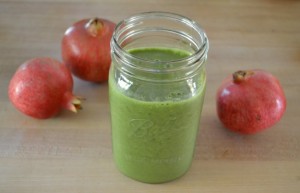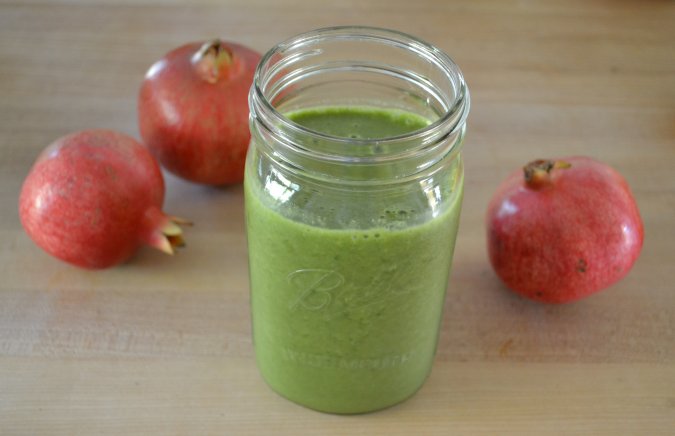Ever since my introduction to raw food 25 years ago, I noticed that there are at any given time a number of raw food enthusiasts who choose to limit their intake of vegetables, especially leafy greens, for various reasons. From my own research, clinical and personal experience, I have found that leaving out these important foods decreases the amounts of important nutrients in one’s diet.
In a recent video I show the content of selected important nutrients in three different smoothies: a fruit smoothie, the same fruit smoothie with dandelion greens added, and the same fruit smoothie with kale added. The nutrient differences between the non-green smoothie and the green smoothies are astonishing, especially for calcium and iron. Here is a chart summarizing the differences:
| Fruit Smoothie | Fruit smoothie plus dandelion greens | Fruit smoothie plus kale | DRI | |
| Calories | 436 | 510 | 536 | |
| Calcium | 110 | 418 | 381 | 1000 mg, 1200 mg |
| Iron | 2.0 | 7.0 | 5.4 | 8 mg, 18 mg |
| Magnesium | 118 | 177 | 136 | 310 mg, 420 mg |
| Potassium | 1484 | 2139 | 2382 | 4700 mg |
| Folate | 157 | 202 | 216 | 400 mcg |
Fruit smoothie recipe:
- One Valencia orange
- Two bananas
- 2 cups pineapple chunks
- ½ cup blueberries
- ½ cup strawberries
- ¼ cup blackberries
Fruit smoothie plus dandelion greens: the ingredients in fruit smoothie with 3 cups of dandelion greens added
Fruit smoothie plus kale: the ingredients in fruit smoothie with 3 cups of chopped kale added
Calcium and Iron: The dandelion greens and kale increase the content of all nutrients listed in the table significantly, especially iron and calcium. The amounts of calcium and iron in the fruit smoothie alone are a good start, but when leafy greens are added, the amounts of these important minerals increase dramatically. Per calorie, the green smoothies are a great value calcium and iron-wise and go a long way in helping to provide the adult DRIs (Dietary Referenced Intakes) for these important nutrients. Without leafy greens, one would be missing out on these nutrients and the health value they provide.
Magnesium: Leafy greens are a reliable source of magnesium because of their chlorophyll content. Chlorophyll is the green coloring that one finds green plants, especially in leaves. The mineral at the center of the chlorophyll molecule is magnesium, so it is not surprising to see that the magnesium content of this smoothie notably increased when leafy greens were added.
Folate: Also known as vitamin B9, folate got its name from the Latin word for foliage, which makes sense given that some strong sources of folate are leafy greens. As evidenced in the table above, adding leafy greens to one’s diet can increase folate intake in many cases significantly. Folate is critical for cell division and DNA replication along with vitamin B12, and has a synergistic relationship with vitamin B12. For clarification of this relationship please see my previous blog post and video on folate and vitamin B12.
Potassium: Fruit is known as a great source of potassium and leafy greens can contain a notable amount of this important alkaline mineral, as the table above indicates.
Many more: There are so many more important nutrients found in leafy greens that we talk about in our book, the Raw Food Nutrition Handbook: An Essential Guide to Understanding Raw Food Diets. Some of these nutrients include the essential omega-3 fat alpha-linolenic acid, carotenoids lutein and zeaxanthin, protein, vitamins C and E, and many more. Many of these important nutrients work together synergistically to create an effect that is greater than the sum of the individual nutrients, so getting them from a whole food source is important. But if we don’t eat the food, we don’t get the nutrients. I see leafy greens and vegetables in general as playing a necessary role in a healthy raw food plant-based diet.
Video summarizing the points covered in this article:
One of the best ways to keep in touch with us is to join our email list. You’ll receive a free copy of Our Top 12 Strategies for Long Term Success on A Raw Plant-Based Diet eBook along with regular information about raw food and plant-based diets and periodic promotions for our classes, events, and other offerings!
Video for My Pomegranate Green Smoothie Recipe
Here is the recipe:
½ cup of fresh pressed pomegranate juice
1 cup fresh pressed Valencia orange juice
2 medium bananas, peels removed
3 cups chopped kale, loosely packed
1 cup chopped mangoes, peels removed
½ cup blueberries
½ cup blackberries
Here is a nutrient analysis of the ingredients in this smoothie:
| Adult Daily Values | ||
| Protein | 15 grams | |
| Calcium | 361 | 1000 – 1200 mg |
| Iron | 5.7 | 8 – 18 mg |
| Zinc | 2.2 | 8 – 11 mg |
| Magnesium | 203 | 310 – 420 mg |
| Potassium | 2876 | 4700 mg |
| Vitamin C | 462 | 75 – 90 mg |
| Vitamin E | 4.0 | 15 mg |
| Vitamin B1 | 0.7 | 1.1 – 1.2 mg |
| Vitamin B2 | 0.7 | 1.1 – 1.3 mg |
| Vitamin B3 | 6.6 | 14 – 16 mg |
| Vitamin B5 | 2.3 | 5 mg |
| Vitamin B6 | 1.9 | 1.3 – 1.7 mg |
| Folate | 258 | 400 mcg |
| Beta carotene | 19538 mcg |
This is one of my post-workout green smoothies. On days that I do not have a big workout, my smoothies are usually smaller.
One of the best ways to keep in touch with us is to join our email list. You’ll receive a free copy of Our Top 12 Strategies for Long Term Success on A Raw Plant-Based Diet eBook along with regular information about raw food and plant-based diets and periodic promotions for our classes, events, and other offerings!
Pomegranate Green Smoothie
One of the many things we love about this time of year is pomegranates and while visiting some friends this weekend, we enjoyed ripe, backyard-grown pomegranates. I do not believe that I have ever seen pomegranates this red and ripe – so ripe that the outer skins were splitting to reveal deep red colored arils in the inside. Pomegranate arils are delicate, red fluid-filled pouches that surround individual pomegranate seeds. The juice we made with these pomegranates had a rich and smooth flavor with no trace of bitterness at all. We used some of the juice to create some recipes including this green smoothie:
½ cup of fresh pressed pomegranate juice
Juice of three medium Valencia oranges
3 medium bananas
3 cups chopped collard greens
Here is a nutrient analysis of the ingredients in this smoothie:
| Adult Daily Values | ||
| Calories | 597 | |
| Calcium | 328 | 1000 – 1200 mg |
| Iron | 1.71 | 8 – 18 mg |
| Zinc | 1.20 | 8 – 11 mg |
| Magnesium | 152.0 | 310 – 420 mg |
| Potassium | 2304.9 | 4700 mg |
| Vitamin C | 253.9 | 75 – 90 mg |
| Vitamin E | 3.32 | 15 mg |
| Vitamin B1 | 0.54 | 1.1 – 1.2 mg |
| Vitamin B2 | 0.59 | 1.1 – 1.3 mg |
| Vitamin B3 | 4.40 | 14 – 16 mg |
| Vitamin B5 | 2.71 | 5 mg |
| Vitamin B6 | 1.77 | 1.3 – 1.7 mg |
| Folate | 424.7 | 400 mcg |
| Beta carotene | 4241.4 | |
| Protein | 11.7 |
I found the calcium, potassium, magnesium, vitamin C, vitamins B1, B2, B3, B5, and B6, folate, beta carotene, and protein content of this smoothie to be impressive! Especially for almost 600 calories (kcal), which is a little more than one quarter of my calorie intake for a day when I am exercising. FYI, I am not one to count calories, but I find that I naturally consume more calories on days when I exercise than not. Since this is a high fruit smoothie, I really appreciate it pre- or post-workout. For example, late last week, I had this smoothie a couple of hours before running, and found that I had a tremendous amount of energy during my run, so much that I actually ran a couple of extra miles longer than my original plan. I felt great the next morning with almost non-existent muscle soreness, despite my longer than usual run.
For those who do not prefer such a high fruit smoothie, there are a variety of substitutions that one can make for the bananas and OJ. If you have any suggestions, we would love to hear from you. We wish you an enjoyable thanksgiving or thanksliving 🙂
One of the best ways to keep in touch with us is to join our email list. You’ll receive a free copy of Our Top 12 Strategies for Long Term Success on A Raw Plant-Based Diet eBook along with regular information about raw food and plant-based diets and periodic promotions for our classes, events, and other offerings!
My post-workout berry green smoothie
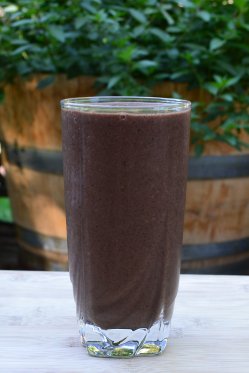 Rick and I have a very active lifestyle and enjoy having a constant amount of energy throughout the day. On days that I exercise, I find that a fruit-containing green smoothie gives me that extra edge, energy-wise. Here is a recipe for one of my favorite post-workout green smoothies:
Rick and I have a very active lifestyle and enjoy having a constant amount of energy throughout the day. On days that I exercise, I find that a fruit-containing green smoothie gives me that extra edge, energy-wise. Here is a recipe for one of my favorite post-workout green smoothies:
2 medium bananas
1 cup orange juice (juice of 3 oranges)
3 cups chopped collard greens (6 medium tree collard leaves)
½ cup fresh raspberries
½ cup fresh blueberries
Here are some of the nutrients found in this smoothie:
| Green smoothie | Adult Daily Values | |
| Calories | 421 | |
| Protein | 8.00 g | |
| Calcium | 210.1 | 1000 – 1200 mg |
| Iron | 1.70 | 8 – 18 mg |
| Zinc | 0.74 | 8 – 11 mg |
| Magnesium | 105.2 | 310 – 420 mg |
| Potassium | 1580.4 | 4700 mg |
| Beta carotene | 4316.2 mcg | |
| Vitamin C | 201.8 | 75 – 90 mg |
| Vitamin E | 3.20 | 15 mg |
| Vitamin B1 | 0.38 | 1.1 – 1.2 mg |
| Vitamin B2 | 0.42 | 1.1 – 1.3 mg |
| Vitamin B3 | 3.67 | 14 – 16 mg |
| Vitamin B5 | 1.64 | 5 mg |
| Vitamin B6 | 1.18 | 1.3 – 1.7 mg |
| Folate | 305.3 | 400 mcg |
The nutrient content of this smoothie is notable and after running four miles today, this smoothie was a welcome treat.
Here is how I made this smoothie:
First, I squeezed the juice from three oranges, peeled two ripe bananas, and gathered and rinsed 6 medium-sized leaves from our tree collard plants. I placed the juice, bananas, and collard greens into our blender:
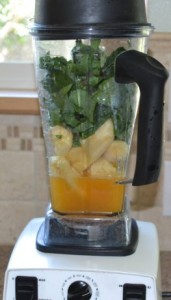
I blended the ingredients until smooth and added the rinsed blueberries and raspberries:
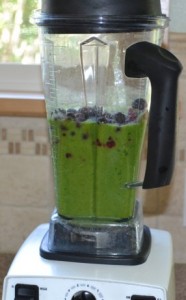
Once again, I blended the mixture until smooth and enjoyed my smoothie.
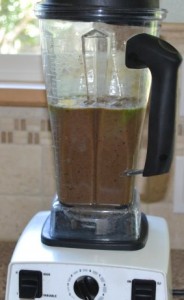
The blueberries and raspberries give this green smoothie a lovely purple-brown color. 🙂
One of the best ways to keep in touch with us is to join our email list. You’ll receive a free copy of Our Top 12 Strategies for Long Term Success on A Raw Plant-Based Diet eBook along with regular information about raw food and plant-based diets and periodic promotions for our classes, events, and other offerings!


